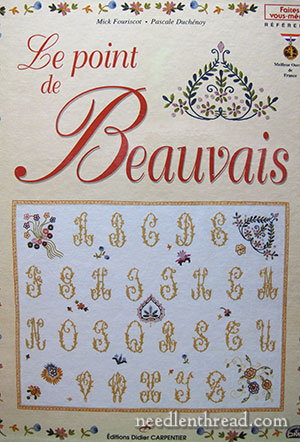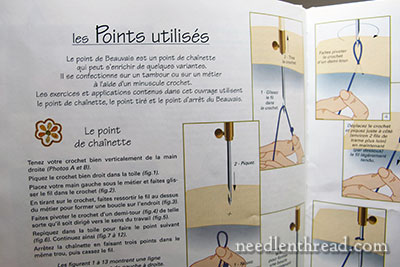Remember when we delved into tambour embroidery for a brief spell at the end of last year?
Well, I haven’t dropped the subject entirely. I’m going to revisit it one of these days – and in the meantime, I’ve been doing some reading, practicing, studying, exploring…
Along the way, I met up with another tambour embroidery book that I think is very worthwhile to have in your collection, if you’re keen on tambour work.
While I still prefer Yusai Fukuyama’s book Tambour Work overall, this particular book, called Le Point de Beauvais by Mick Fouriscot and Pascale Duchénoy, offers some particular reasons for particularly liking it!

Le Point de Beauvais is written in French, but if you don’t speak French, don’t let this deter you!
The book is fully illustrated with detailed diagrams, so that the instruction is perfectly clear.
The book is not text-heavy. If you need or want to translate any of it, you can easily type short blurbs into an online translator to get a fairly decent translation.

The book begins with materials, including a nice photo series on setting up the tambour frame.

But real draw in this book is the instructional diagrams for tambour embroidery. They are Very Clear. They leave no guessing at all, even if there is a language barrier.

Besides the basic chain stitch, you’ll also find instructions on other stitches used in tambour work, including stitches that can be adapted to a kind of long & short stitch filling approach and that result in filled areas that look like satin stitch or even fly stitch, depending on how you work the stitch.

You’ll also find several projects in the book. The projects include the pattern, the suggested colors used, a close up of the finished embroidery, and stitch placement guidelines and stitch direction guidelines, where necessary.

There’s a very pretty alphabet, too, that can be used for single decorative initials, or that can be worked up into a whole alphabet sampler like the one featured on the cover.
So, if you’re a tambour embroidery enthusiast, or if you’re trying to teach yourself tambour embroidery, Le Point de Beauvais is definitely worth adding to your library!
Finding Le Point de Beauvais
The book is available in France pretty widely. You can find it on Amazon France.
In the US, it’s a little harder to come by. Lacis doesn’t carry it (though they do have another book on the topic, which I’ll be reviewing down the road).
In the US, you can currently find some used copies of Le Point de Beauvais available through Amazon.
You can also find it through other used book sources like Advanced Book Exchange, where you’ll find more copies available and can filter by country. Remember to check where the copy is coming from and to notice shipping charges before placing an order.
Down the road a bit, I’ll show up up close another tambour book and do a comparison, so you can better decide which book or books you’d like to add to your library or seek through your local library system.







Dear Mary
I’ve learnt how to embroider with the Tambour hook using the chain stitch but I would love to learn other stitches and other forms of technique in Tambour work which Le Point de Beauvais book covers. I’ve just completed making a beaded evening bag from scratch using Tambour work which was interesting, I’ve even made a beaded handle as well to go with the bag, this was an interesting project which I enjoyed. This book will go on my wish list and I can’t wait for your review on the other Tambour book. Thanks for sharing this with us very useful.
Regards Anita Simmance
Marie,
Great, a book that I did not need to translate. We can still find in France thread of No. 40 stitch embroidery of Beauvais. Which thread do you now? because I know that no longer makes the DMC No. 40, I have never tried this type of embroidery but I could admire. Is there a good way to learn to make embroidery on tulle?. Because I’m a little lost in this kind of embroidery.
Thank you Mary
Dear Mary,
This book and, shop carefully, another with an almost identical title are available through AbeBooks.com, an interesting and reliable site.
Jane
Mary, I am not sure if I mentioned this earlier or not, but I was wondering if you have ever used a (Russian) punch needle? If so is it very different from the tambour? And if you have, would you be able to do a post on it sometime please? I bought one of these a long long time ago, never got the hang of it and recently found it again. Soooo……
Hi, Christina – Yes, it’s quite different. The punch needle feeds the thread from the inside of the shaft of the needle, out through a hole in the tip of the needle. You work on the back of the fabric, and on the front, little loops form – like loops of carpet – to create a piled surface on the front. On the back, you end up with straight stitches. I don’t really do punch needle, even though I have a set somewhere. It’s not really my thing – I think it’s neat, and I’ve seen it used for some pretty impressive needlepainting-type approaches – but I’ve never really gotten into it myself. But maybe I can put together an information post with some tips…
G’day Mary,
I love the thought of those illustrations. That alphabet is darling.
Thank you, cheers, Kath